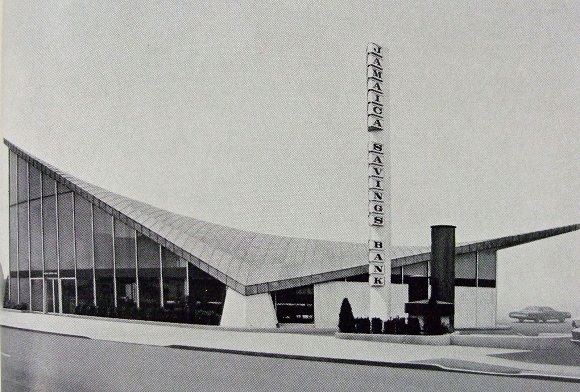A new effort is underway to push for land-marking status of what is known as the ‘Jamaica Savings Bank’ building. This building, located at 89-01 Queens Boulevard, a familiar part of the boulevard’s landscape, was constructed in 1966-1968 as a branch of that bank, and is a unique example of modern architecture, or 60’s ‘space age,’ as some may prefer to call it, positioned against a backdrop of otherwise unmemorable structures, with many more bland examples cropping up along the boulevard. One can only imagine the impact from an observer’s eyes, just after its completion, prior to the distracting clutter of other structures, eyeing its triangular glassy shape, its sleekness, and curvature. Nowadays, when passing along, or peering from the other side of the Blvd, this wondrous sight may get lost in the shuffle, unless one beckons closer for a more detailed inspection.
The building’s history too, is fraught with a question. Its status was recognized as a landmark by vote from the Landmarks Preservation Commission in 2005, but this was soon rescinded by the city council, after giving in to the complaints from ownership. This was a rare case indeed, as it passed through the process done by the LPC, which has a stringent set of guidelines, and gave their thumbs up, only to be thwarted by the City Council.
At this time, the Elmhurst History and Cemeteries Preservation Society, a 501c3 not for profit small group of dedicated preservationists and civic members, are preparing to apply for landmark status once again. Councilman Daniel Dromm, who represents the area, has promised a letter of support for land-marking, making it clear he’s not sure what happened with the decision-making back in 2005. His predecessor, Helen Sears represented the district, and the bulk of the City Council, were swayed by the ownership’s argument, with hired legal representation, which claimed the building had flooding and maintenance issues.
With this new effort, Simeon Bankoff, Executive Director of the Historic District Council says, “This building is an excellent example of mid-century design and helps show the breadth and diversity of historic architecture in Queens.” Back in 2005, Bankoff asserted that people have a hard time ‘warming up’ to modern architecture, especially something built during their memory.
In fact, City Council subcommittee chair on landmarks at that time, Simcha Felder, assumed a peculiarly harsh stance, and Councilperson Sears, who pledged support for this designated building in her district after the LPC’s vote of approval, then began to waver in her opinion, allowing room for the rest of the council to fall in line with the subcommittee chair’s hard line response against. It has been almost fifteen years, and in that time, it is hoped a more thoughtful, responsible, consideration for such a rare structure will hold sway over any manageable concerns. Perhaps then, with changing times, a strong convincing case, a new designation by the Landmark Commission, and with a unanimous positive response from the City Council, this new push will succeed.
The bank building, designed by architect William F. Cann was a one-of-a-kind construction back then, an outgrowth of the World’s Fair era 1963-1964, as well as a prime example of mid-century modernist designed structures. The cost for the 82×82-foot building was $350,000. It opened on March 25, 1968. Licensed tour guide Linda Fisher remarks, “To me, the Jamaica Savings Bank building is as iconic as the Unisphere. It symbolizes hope for the future as envisioned in the mid-century, and it stands midway between the city (Manhattan) and the suburbs (Nassau), reflecting the diverse nature of the Queens landscape – a place for everyone to call home.”
The grand circular Macy’s building, now the Queens Place Mall, stands directly across 56th Avenue on the same side of the Blvd, and opened in 1964, with great fanfare. The building became North Fork bank which bought out Jamaica Savings Bank in 1999, and now houses a Bank of America branch. It was an experiment in style, veering away from the old squarelike classic stone beige banks of the past era, and brings to mind works of modern master architects; simplistic in its outward beauty with its rigid slopes. To the layperson, the word triangular may fit, but it is called a ‘hyperbolic paraboloid,’ an unusual shape without right angles. It can also be associated with ‘Googie’ type architecture, a term which denotes ‘futuristic’ or ‘space age’ architecture, popular from the late 1940’s into the mid 1960’s; an example of which is the TWA Flight Center by Eero Saarinen; of which the Jamaica Bank building with its wing-like image bears resemblance. “Googie’ also refers to the bold use of glass, steel, or neon, and is almost interchangeable with another term ‘Populuxe.” These kinds of buildings, part of Americana, are now appreciated for their drive and ambition in post-World War Two society, and not all have survived.
Hence, the need has arisen as the ever-changing landscape, has significantly altered more rapidly in our times than ever before. “There are few modernist landmarks in Queens, or throughout the boroughs, which should make the case for re-applying for landmark status that much stronger. As a historic preservationist, I deem it to be a landmarking priority. The fact its status was overturned in 2005, proves how some elected officials do not appreciate the ‘diverse’ styles that offer Queens its distinctive presence. The lack of landmarks is politically unjust! They cast a spirit, celebrate Queens culture, bear homage to the architects and builders and tell us a story,” concluded Michael Perlman, Queens preservationist.




